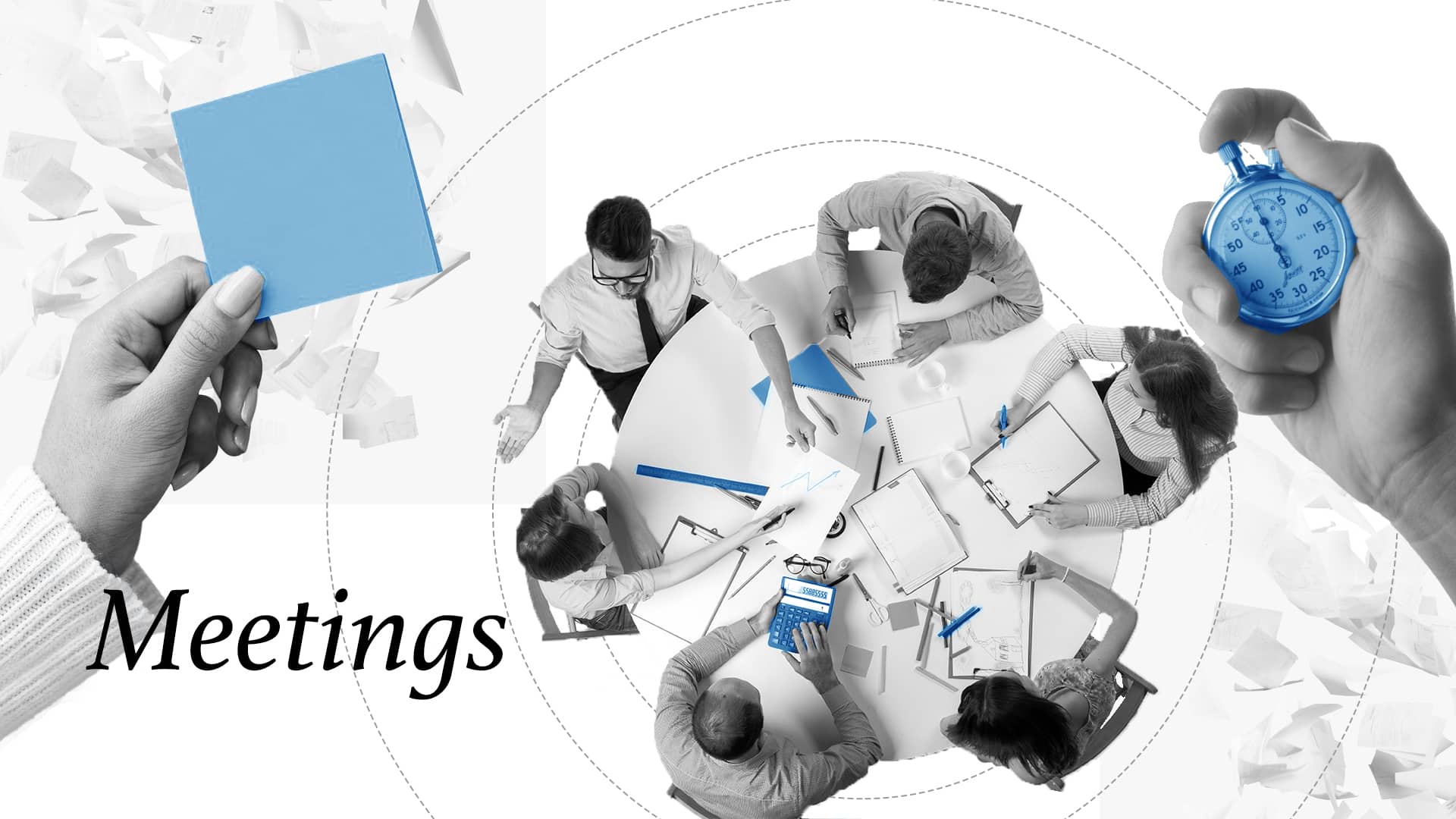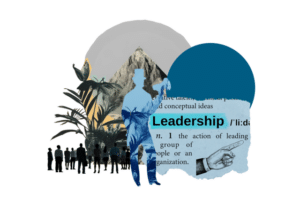“Let’s talk about it in the meeting”, “Sorry I can’t right now, I’m in a meeting”, “I have to jump on another call that I am already late for”, “No! Is that meeting tomorrow as well?”, “Who are all these people in the invitation? There are 35 of us.”
How many times do we repeat these statements during our workday?
As most of our corporate schedules revolve around different meetings, some have been shown, to not be successful nor productive whatsoever. Often we find out that the people involved are not necessarily the right ones; leading towards poor time management as well poor productivity levels. Thus consequently, causing higher chances of disruption and confusion on the actual tasks that need to be focused on and tackled.
Studies have shown, that even before the pandemic, most executives, have spent an average of 40% to 50% of their work time in meetings, of which more than 33% are considered unproductive. During the meeting 9 out of 10 participants are distracted and think about something else, 73% of them perform other tasks, and in 25% of cases, the feeling is that they have discussed irrelevant and useless topics. All this translates into 2 whole months of work per year completely wasted, with a significant negative impact on the economy and productivity of companies.
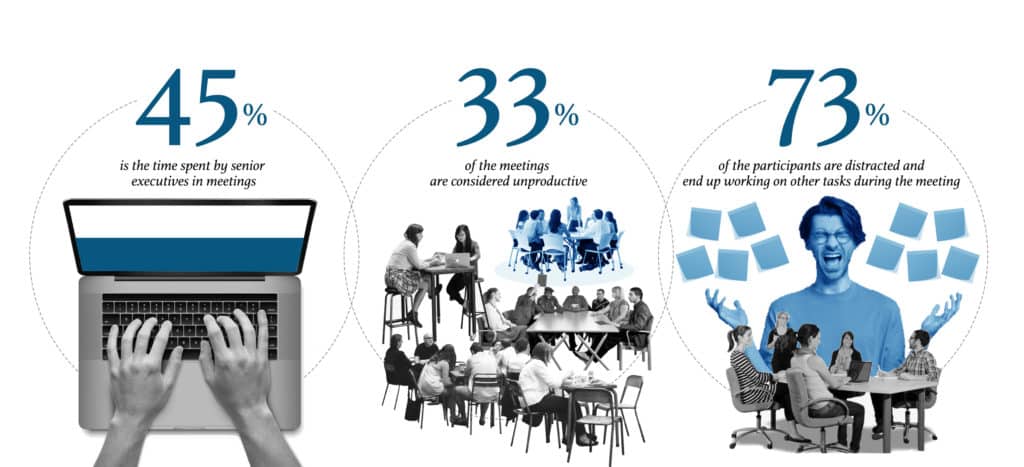
With remote work, there has been an increase of 13% in creating more meetings. As it is much faster, with a click of a button, all we have to do is create a virtual room and send the invitation by e-mail; consequently, allowing more space for additional meetings.
As if time were to be an infinite resource.
The shared perception of being constantly in a videoconference leads to a condition that causes the so-called “zoom fatigue“. The feeling of physical, mental, emotional, and motivational fatigue, is caused by spending many hours in front of the PC screen.
The question we should be asking ourselves is: How many of the meetings we hold, and to which we are invited to, are necessary and worthwhile? How many end up being a waste of time, because we are not efficient enough?
As David Grady, Information Security Manager had already pointed out in his 2014 Ted Talk, meetings, when effective, are a powerful tool for businesses because they facilitate the alignment of individuals, toward the same goals and thus incentivized collaboration. Good meeting management is essential not only to optimize our time and energy but also because it allows us to raise the level of individual and team performances. It increases productivity and facilitates the achievement of desired results; improving collective dynamics, and consequently organizational effectiveness. Learning how best to organize them, is the first step.
But a good meeting is not only made of an impeccable organization. Human beings are not machines and for this reason, a maieutic approach or a Coaching modality can constructively allow managing the emotional and relational spheres related to the dynamics that occur during a meeting.
For this reason, it is necessary to integrate the canonical discipline of good meeting management with the practice of Team Coaching, which will enable certain behaviors, both individually and collectively.
So what does good meeting management mean? And what specifically can we learn from the Business Coaching approach in particular, from the practice and experience of Team Coaching in relation to meetings?
How to structure an effective meeting
To be effective, a meeting needs first of all to follow a well-defined structure, which allows keeping control of its development, to properly distribute the time, the different tasks to tackle, and the objectives for which need to be met.
This includes not only the process phase, but also the introductory phase, the conclusion, and finally what happens after the meeting.
Before the meeting clearly define:
- The objective
- The tasks for the day
- Save the date on the calendar
- Who needs to be involved
Then clearly define the purpose and objectives of the meeting. The reasons for holding a meeting can be many: to give or receive information from employees, to solve specific problems, to generate innovative ideas or strategies, to make decisions and plans of action, to get clarification, to negotiate, to create and strengthen the team, to improve relationships between people, and to update and take stock of the situation.
When drawing up the tasks for the day, specify and share with all participants the topics that will be covered and assign any responsibilities and tasks: this is necessary so that everyone is clear about what they need to do and prepare for the meeting. It may be helpful to put the topics in question form so that people are encouraged to prepare and move towards a resolution.
The timing of the meeting, and the length of time it lasts, affect the attention and energy of the participants and therefore makes a difference to their performance and active participation. Often in organizations, this aspect is not taken into account and meetings fail simply because the time is incompatible with the participants.
The typical result? People connect, but the whole time they’re doing something else instead of following along and contributing.
Choosing who to invite to the meeting is a crucial issue in many organizations. The thought of more people attending, the better the outcome is in reality unproductive.
Meetings are not college parties where the criteria are the number of attendants.
We need to make sure that only those who are involved, interested, and who can make a real contribution to what the topic is, will attend.
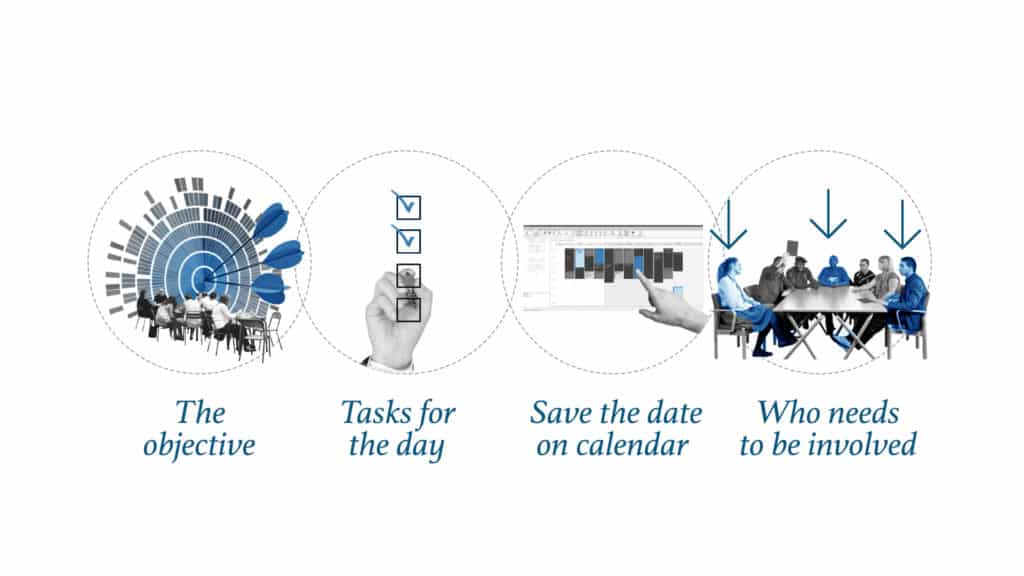
During the meeting, it is necessary to:
- Have a clear outline of the agenda
- Good TIME MANAGEMENT
- Include participants
- Have a clear summary and outline for future tasks
The initial moment determines the course of the whole meeting because it creates involvement, engages the participants, and clear message for their contribution. Sometimes it is also necessary to introduce the participants and set aside some time for the initial small talk: people are not machines and they need to feel comfortable in the social as well as the operational dimension of the meeting.
At this point, it is important to introduce the participants to the objective of the meeting: what does this mean in terms of interpersonal dynamics? We find here two key steps: first, make sure that people are aligned to the goal and if necessary adjust it so that everyone can be up to speed and prepared for it. Secondly, make sure that everyone’s interventions take place in the field of action for the tasks and responsibilities they individually and collectively have.
On-time management, many get it wrong. Conducting the meeting means paying attention to the timing, which must be respected. In this regard, it is important to first establish how much time to devote to each topic, and during the meeting make sure to keep the focus on the agenda. Avoid interrupting those who are speaking; make an effort to set out your ideas clearly; make sure that everyone understands; take short breaks to take stock of the situation and provide frequent reminders to those involved. This allows you to maintain the thread of the meeting, not to divert from it, but to stick to those topics that are key to the objective.
Another issue is, how to involve those who never contribute? How to ensure that all participants have the opportunity to express their point of view and engage actively is a great challenge. To do this, it is necessary to create a positive and proactive climate, in which everyone has room to intervene, as well as to encourage those who have not yet expressed themselves.
Even here, Team Coaching can help us: it is important to make sure that opinions are expressed as opinions and not as judgments. Listening amongst each other to deliver constructive feedback as well as welcoming new strategies.
In conclusion, it is necessary to define a work plan. Often this final phase is underestimated or skipped for lack of time. In fact, for a meeting to be truly useful, it must be action-oriented, aimed at putting into practice what was decided in the meeting. It is, therefore, essential to establish who is to do what, by when, and that everyone has understood the next steps. Equally fundamental, even if not always put into practice, is to ask the question “How did the meeting work?“, in terms of how: “did everyone feel they expressed themselves?” “Did everyone feel they made the contribution they expected to make?” “Was the dialogue balanced and not polarized towards some?” The ideal conclusion to a meeting is to review the process through which the dialogue developed and decisions were made because that’s the only way to learn how to do it better the next time.
At the end of the meeting then it can be useful to compile a summary report and call a follow-up or update meeting to check how things are progressing.
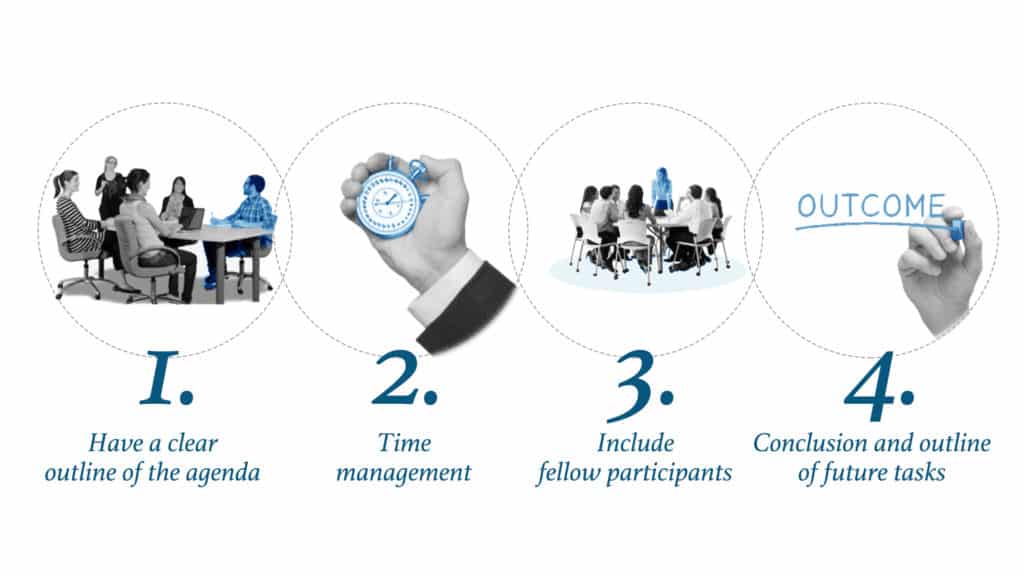
The skills for good meeting management
Once, at least formally, we have all the elements for a successful meeting, what skills do we need to train to ensure that we maximize our effectiveness, and that of the whole team, and thus make a difference to the outcome of the meeting? Even considering the behaviors to be implemented in the various stages of preparing and conducting meetings, the skills that are essential, and therefore make sense to include, are:
- Active listening
- Effective interpersonal communication
- Time management
- Self-management
- Result orientation
- Emotional intelligence
Active listening means adopting an attitude of openness towards speakers, showing genuine curiosity about their point of view. Listening facilitates a constructive and fruitful exchange and encourages people to express their opinion. It is precisely for this reason that the suspension of judgment becomes fundamental: showing interest and attention even to opposing points of view and valuing the contribution of each participant is functional to collaboration because it creates involvement and cohesion towards the common goal.
It is also important to have effective interpersonal communication that is fluid, clear, and complete. This can be done by clearly articulating your point of view and making sure that everyone understands all the points being made, taking time to clarify any doubts or misunderstandings. To facilitate the verbal exchange, it is useful to use tools such as a presentation, slides, screen sharing, etc…
Time management, as already mentioned, is a crucial issue: as we have seen, managing meetings means defining priorities according to clear, explicit, and shared criteria. Establishing preliminary time slots for each task or topic, avoiding distractions, and focusing on activities that are strictly functional to achieving the objectives. All of this is linked to good self-management and results in orientation, i.e. the ability to clearly define the results to be achieved, the activities to achieve them, and the available resources required. This allows you to keep the focus on the key objectives of the meeting, and not leave room for non-priority activities.
At the end of the tier, we find the management of emotion; of their own and others. Why do we think this is a key skill in meeting management? Because meetings are often occasions with a high emotional impact: they can deal with issues in which the stakes are higher. There is stress and fear of speaking in front of everyone, they are moments in which one is confronted with those who think differently from oneself, and for this reason, it is important to be able to avoid transforming the dialogue into a conflictual clash, in which the common objective is replaced by individual interests.
By starting to reflect on these aspects, to put into practice more effective behaviors and strengthen these skills, we can not only optimize the dynamics of the meetings we have, but also live them better: not as a burden, which takes away energy and time that we could more wisely engage in other things, but constructively and proactively, as a real moment of growth and learning, personal and collective at the same time.
